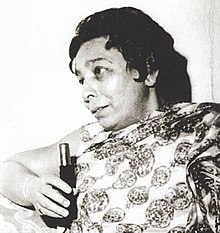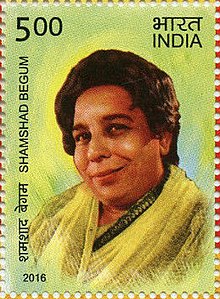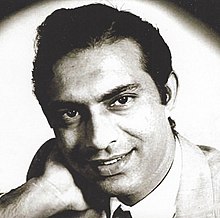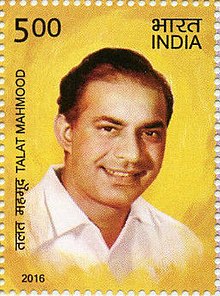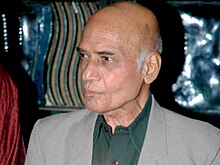Naushad
From Wikipedia, the free encyclopedia
(Redirected from
Naushad Ali)
Jump to navigationJump to search
improve it or discuss these issues on the
talk page.
(Learn how and when to remove these template messages)
This article may
require cleanup to meet Wikipedia's
quality standards.
(November 2011)
This article
needs additional citations for verification.
(November 2011)
Naushad Ali
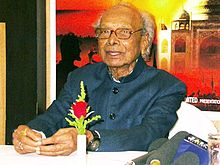
Naushad Ali in 2005
Background information
Born 25 December 1919
Lucknow, India
Died 5 May 2006 (aged 86)
Mumbai, India
Genres Hindustani classical music,
Indian film music
Occupation(s) Composer, music director, film producer, writer, poet, producer
Instruments Harmonium, sitar, piano, tabla, flute, clarinet, accordion, mandolin
Years active 1940–2005
Associated acts Lata Mangeshkar,
Asha Bhosle,
Mohammad Rafi,
Mukesh (singer),
Shamshad Begum,
Shakeel Badayuni
Naushad Ali (26 December 1919 – 5 May 2006) was an Indian music director for
Hindi films.
[1] He is widely considered to be one of the greatest and foremost music directors of the Hindi film industry.
[2] He is particularly known for popularising the use of
classical music in films.
[3]
His first film as an independent music director was
Prem Nagar in 1940.
[4] His first musical success film was
Rattan (1944), following it up with 35 silver jubilee hits, 12 golden jubilee and 3 diamond jubilee mega successes. Naushad was conferred the
Dadasaheb Phalke Award and the
Padma Bhushan in 1982 and 1992 respectively for his contribution to the Bollywood film industry.
[5]
Contents
Early life and education[edit]
Naushad was born and raised in
Lucknow, a city with a long tradition as a center of
Indian Muslim culture. His father, Wahid Ali, was a munshi (court clerk). As a child, Naushad would visit the annual fair at the Deva Sharif in
Barabanki, 25 km from Lucknow, where all the great qawwals and musicians of those days would perform before the devotees. He studied
Hindustani music there under Ustad Ghurbat Ali, Ustad Yusuf Ali, Ustad Babban Saheb and others. He also repaired harmoniums.
As a lad, he joined a junior theatrical club and was appointed the club's music maestro for their theatrical presentations. He used to watch silent films at the Royal theatre in Lucknow. Theatre owners would hire a team of musicians to play the
tabla,
harmonium,
sitar and violin. The musicians would watch the film first, make notes, finalize the scales required. When the show began in the evening, they would sit in front of the screen and play music for the scenes. This was a great way to be entertained and learn music at the same time. It made him grasp the nuances required in composing a film's background music score.
In time Naushad formed his own Windsor Music Entertainers or just Windsor Entertainers, so named because he had seen the word "Windsor" around Lucknow and liked its ring. It led to the Indian Star Theatrical Company in a theatre at Golaganj colony in
Lucknow. He was trained under Laddan Khan until he became capable of working independently as a composer. There he also developed the sense to pick rare musical jewels from the folk tradition of
Punjab,
Rajasthan,
Gujarat and
Saurashtra during the company's sojourns in those regions. The travelling players got as far as
Viramgam in Gujarat, where they discovered penury, even after selling off theatrical props and musical instruments. The company limped back to Lucknow through the kindness of one of Naushad's friends.
Naushad had already become a cinema fan in the silent era and then, in 1931, Indian cinema got voice and music that further fascinated the 13-year-old boy. But his family was strict follower of Islamic diktat of prohibition of music and his father gave him ultimatum to leave music if he wanted to stay at home. He ran away to
Mumbai in the late 1937 to try his luck as a musician.
Career[edit]
In
Mumbai, he initially stayed with an acquaintance from Lucknow (U.P.) at
Colaba and after a while, shifted to
Dadar opposite the Broadway theatre where he would sleep on the footpath. He assisted music director Ustad Jhande Khan who was at the peak of his success those days, at a monthly salary of Rs 40. The producer was a Russian and the studio was at
Chembur. The film could not be completed. Naushad was a piano player so he worked as a pianist in composer Ustad Mushtaq Hussain's orchestra. He then polished off an unfinished film score and got a credit as assistant to Hussain. Then the film company collapsed. Composer
Khemchand Prakash took him on as his assistant for the film
Kanchan at
Ranjit Studios at a salary of Rs 60 per month, for which Naushad remained extremely grateful and in interviews, he had called Khemchand his guru.
His friend, lyricist
D. N. Madhok, trusted Naushad's unusual talent for composing music and introduced him to various film producers.
Chandulal Shah, the owner of Ranjit Studios, offered to sign Naushad for one of his forthcoming films. Naushad composed a
thumri for this film, "Bata de koi kaun gali gaye Shyam", but the film never got on the floors. He was assistant music director for the Punjabi film
Mirza Sahib (1939).
He composed for his first independent film
Prem Nagar in 1940 that had a story set in
Kutch for which he did a lot of research into the folk music of the area. With
A.R. Kardar's film
Nayi Duniya (1942), he got first credit as "music director" and he began to work regularly for Kardar Productions. He however had a flexibility that he could work outside Kardar Productions and this arrangement continued ever after. He first got noticed with A.R. Kardar's film
Sharda (1942) wherein 13-year-old
Suraiya debuted with the song "Panchhi Ja" for the playback for heroine
Mehtab. It was
Rattan (1944) that took Naushad right to the top and enabled him to charge Rs 25,000 a film during those days.
Film expert and author Rajesh Subramanian opines that Kardar production spent Rupees seventy five thousand in 1944 to make
Rattan. The music by Naushad saheb was such a phenomenal hit that the company earned Rs 3 lacs as royalty from gramophone sales in the first year.
But his Lucknow-based family remained against music and Naushad had to hide from his family the fact that he composed music. When Naushad got married, the band was playing the tunes of the super hit songs of Naushad's film 'Rattan'. While Naushad's father and father-in-law were condemning the musician who had composed these songs, Naushad dared not tell them that it was he who had composed the music.
From 1942 until the late 1960s, he was one of the top music directors in Hindi films. While he did less than a hundred films during his lifetime, 26 of those films celebrated Silver jubilees (25 weeks run) – 8 celebrated golden jubilees (50 weeks run) and 4 celebrated diamond jubilees (60 weeks run). (inclusive count – a diamond jubilee film also celebrated Silver and Golden jubilee)
Naushad worked with several lyricists, including
Shakeel Badayuni,
Majrooh Sultanpuri,
D. N. Madhok,
Zia Sarhadi, and
Khumar Barabankvi.
Mother India (1957), for which he had composed music, was the first Indian film that got nominated for Oscar.
In 1981, Naushad was awarded the
Dadasaheb Phalke Award for his lifetime contribution to
Indian cinema.
He composed the tunes of
Taj Mahal: An Eternal Love Story (2005) at the age of 86.
Amongst his assistants, Mohammed Shafi,
Jerry Amaldev and Ghulam Mohammed stand out prominently.
Five films have been made on his life and work. Biographical books published are Dastaan-E-Naushad (Marathi) by Shashikant Kinikar; Aaj Gaawat Man Mero (Gujarati); Hindi and Urdu biographical sketches in Shama & Sushma Magazines respectively, titled "Naushad Ki Kahani, Naushad Ki Zubani"; the last one was translated into Marathi by Shashikant Kinikar. Kinikar also came up with a book titled "Notes of Naushad" which puts together some interesting anecdotes of Naushad's life.
Naushad also composed background music for the TV serial "Akbar The Great" telecast in 1988 which was directed by Akbar Khan, brother of Hindi film stars Sanjay Khan and Feroze Khan as also "The Sword of Tipu Sultan" produced and directed by Sanjay Khan and Akbar Khan which was telecast in 1990 and became very popular.
Last days[edit]
Naushad died on 5 May 2006 in Mumbai. He was buried at the
Juhu Muslim cemetery.
[6]
He is survived by six daughters Zubeda, Fehmida, Farida, Sayeeda, Rashida, and Waheeda and son Rehman Naushad, Raju Naushad & Iqbal Naushad. Rehman Naushad being the eldest of all assisted him in some of his films. Also, Naushad composed music for two movies directed by Rahman Naushad,
My Friend (1974) and
Teri Payal Mere Geet (1989).
Naushad had requested the Maharashtra State Government to sanction a plot for an institution for promoting
Hindustani music. This was sanctioned during his lifetime and the 'Naushad Academy of Hindustani Sangeet' was formed.
Writer[edit]
Naushad was also a respected and published poet and formally launched his book of Urdu poetry entitled Aathwaan Sur ("The Eighth Note") and the Navras label's album titled "
Aathwan Sur – The Other Side of Naushad" having 8 ghazals as part of Hounslow's book fair and festival "Bookmela" in November 1998. The album has lyrics and composition by Naushad, arranged by Uttam Singh.
Track list:
- Aabadiyon Mein Dasht Ka Munzar Bhi Aayega – A. Hariharan – 7:08
- Aaj Ki Baat Kal Pay Kyun Taalo – A. Hariharan & Preeti Uttam Singh – 6:17
- Ghata Chhaayi Thi Saawan Khul Ke Barsa – Preeti Uttam Singh – 7:19
- Kabhi Meri Yaad Unko Aati To Hogi – A. Hariharan & Preeti Uttam Singh – 6:18
- Mujh Ko Muaff Kijiye – A. Hariharan – 5:35
- Peenay Waalay Bekhudi Say Kaam Lay – A. Hariharan & Preeti Uttam Singh – 8:13
- Saawan Kay Jab Baadal Chhaaye – A. Hariharan – 6:50
- Tanhaa Khud Say Baat Karoon – Preeti Uttam Singh – 7:49
Music style[edit]
Naushad was known for his deft adaptation of the classical musical tradition for movies. For some movies like
Baiju Bawra, he composed all scores in classical
raga modes and arranged for the well-known vocalist
Amir Khan to be a music consultant for the film. He could easily work with Western instruments, including the clarinet, the mandolin and the accordion. He could incorporate Western musical idioms in his compositions and compose for Western-style orchestras.
During the early 1940s, recordings were done in quiet parks and gardens after midnight because the studios did not have sound-proof recording rooms. In the gardens there would be no echo and disturbances, unlike the studios where the sound reverberated because of the tin roofs.
For films like 'Uran Khatola' and 'Amar', he recorded the voice of a particular artiste on a scale of 90, then recorded it on 70, then on 50 and so on. After the complete recording, it was played for the scene and the impact it created was terrific.
He was one of the first to introduce sound mixing and the separate recording of voice and music tracks in playback singing. He was the first to combine the flute and the clarinet, the sitar and mandolin. He also introduced the accordion to Hindi film music and was among the first to concentrate on background music to extend characters' moods and dialogue through music. But perhaps his greatest contribution was to bring
Indian classical music into the film medium. Many of his compositions were inspired by
ragas and he even used distinguished classical artistes like
Amir Khan and
D.V. Paluskar in
Baiju Bawra (1952) and
Bade Ghulam Ali Khan in
Mughal-e-Azam (1960).
Baiju Bawra (1952) demonstrated Naushad's grasp of classical music and his ability to bring it to the masses, for which he won the first
Filmfare Best Music Director Award in 1954.
Naushad commented on a pre-release meeting about "Baiju Bawra": “When people heard that the film would be full of classical music and ragas, they protested, ‘People will get a headache and they will run away.’ I was adamant. I wanted to change public taste. Why should people be fed what they like all the time? We presented them with music from our culture and it worked.”
For
Aan (1952), he was the first to use a 100-piece orchestra. He was the first composer to have developed the system of western notation in India. The notation for the music of the film 'Aan' was published in book form in London.
In
Uran Khatola (1955), he recorded an entire song without the use of orchestra, having replaced the sound of musical instruments with choral sound of humming.
For
Mughal-e-Azam (1960) song Ae Mohabbat Zindabad, he used a chorus of 100 persons. He asked
Lata Mangeshkar to render a part of the song "Pyaar Kiya To Darna Kya" in a bathroom that had glazed tiles and then recorded the music to get the echo effect.
For
Ganga Jamuna (1961), he used lyrics in chaste Bhojpuri dialect.
He used just six instruments in the title song of Mere Mehboob (1963).
In 2004, a colorized version of the classic
Mughal-e-Azam (1960) was released, for which Naushad had the orchestral music specially re-created (in Dolby Digital) by today’s industry musicians, while maintaining all the solo vocals from the original soundtrack. To elaborate, the playback vocals (though not the chorus) recorded four decades ago are mixed with orchestra tracks created in the present millennium.
As Indian film music gradually assumed a Western bend starting in the late 1960s, Naushad came to be considered old-fashioned. Composers who could compose
rock-and-roll and
disco-inflected music started getting increasingly popular. Naushad was still esteemed as a maestro, but his talents were sought mostly for historical movies where traditional scores were appropriate.
Filmography[edit]
Music director[edit]
Film Year Director Cast Remarks/Verdict
Prem Nagar 1940 Mohan Dayaram Bhavnani Ramanand, Bimla Kumari, Husn Banu, Rai Mohan, Nagendra, Salu, Gulzar Naushad was assistant for Baaghbaan (1938) and Kanchan (1941). According to him, he had composed one song in each film.
Darshan 1941 Chimanlal Muljibhoy Luhar
Prem Adib, Jyoti, Kaushalya,
Bhudo Advani, Miradevi, M. Nazir, Shakir,
Amirbai Karnataki, Madhusudan
Mala 1941 Balwant Bhatt Jayant, Rose, Jairaj, Nazir, Daya Devi, Heera
Nai Duniya 1942 Abdul Rashid Kardar Jairaj, Shobhna Samarth, Wasti, Azurie, Mazhar Khan.
Hari Shivdasani, Jeevan Debut of Singer Surayya in the song "Boot Karoon main Polish"
Silver Jubilee
Sharda 1942 Abdul Rashid Kardar Ulhas, Mehtab. Wasti, Nirmala, Badri Prasad Silver Jubilee
Station Master 1942 Chimanlal Muljibhoy Luhar Prem Adib, Pratima Devi, Gulab
Kanoon 1943 Abdul Rashid Kardar Mehtaab,
Shahu Modak Silver Jubilee
Namaste 1943 Mohammed Sadiq Sani Wasti, Protima Das, Jagdish Sethi, Misra Silver Jubilee
Sanjog 1943 Abdul Rashid Kardar Charlie,
Anwar Hussain, Mehtab Silver Jubilee
Geet 1944 S. U. Sunny
Shahu Modak, Nirmala, Amir Ali
Jeevan 1944 Mohammed Sadiq Wasti, Mehtab, Badri Prasad, Anwar, Shyam Kumar
Pehle Aap 1944 Abdul Rashid Kardar Shamim, Wasti,
Anwar Hussain, Jeevan, Dixit Rafi's first song for Naushad "Hindustan Ke Hum Hain" in a chorus
Silver Jubilee
Rattan 1944 S Sadiq Amir Banu, Karan Dewan, Swarnalata Diamond Jubilee
Sanyasi 1945 Abdul Rashid Kardar Shamim, Amar, Misra, Shyam Kumar, Naseem Jr., Gulam Mohamad Silver Jubilee
Anmol Ghadi 1946 Mehboob Khan Noorjehan, Surinder, Suraiya Diamond Jubilee
Keemat 1946 Nazir Ajmeri Amar, Sulochana Chatterjee, A Shah, Sharda, Badri Prasad, Sofia, Anwari, Nawab
Shahjehan 1946 Abdul Rashid Kardar Kundan Lal Saigal, Ragini Silver Jubilee
Dard 1947 Abdul Rashid Kardar Uma Devi, Suraiya Debut of Singer Uma Devi (Comedy Actress Tuntun) in the song "Afsana Likh Rahi Hoon"
Silver Jubilee
Elaan 1947 Mehboob Khan Himalaywala,
Leela Mishra, Shah Nawaz
Natak 1947 S. U. Sunny Suraiya, Amar, Sofiya, Kanwar, Sham Kumar, Pratima Devi Silver Jubilee
Anokhi Ada 1948 Mehboob Khan Surendra, Naseem Bano, Murad, Cuckoo Golden Jubilee
Mela 1948 S. U. Sunny Dilip Kumar, Nargis, Jeevan Golden Jubilee
Andaz 1949 Mehboob Khan Dilip Kumar, Raj Kapoor, Nargis Golden Jubilee
Chandni Raat 1949 Mohammed Ehsan Shyam, Naseem Bano
Dillagi 1949 Abdul Rashid Kardar Shyam, Suraiyya, Sharda, Amir Banu, Amar Silver Jubilee
Dulari 1949 Abdul Rashid Kardar Suresh, Madhubala, Geeta Bali Silver Jubilee
Babul 1950 S. U. Sunny Dilip Kumar, Nargis Also as Producer
Silver Jubilee
Dastan 1950 Abdul Rashid Kardar Raj Kapoor, Suraiya, Veena, Suresh Also as Co-producer
Silver Jubilee
Deedar 1951 Nitin Bose Dilip Kumar, Nimmi, Nargis, Ashok Kumar Golden Jubilee
Jadoo 1951 Abdul Rashid Kardar Suresh, Nalini Jaywant Also as Co-producer
Silver Jubilee
Aan 1952 Mehboob Khan Dilip Kumar, Nimmi, Nadira Golden Jubilee
Baiju Bawra 1952 Vijay Bhatt Bharat Bhushan, Meena Kumari Film debut of singers Amir Khan and D. V. Paluskar in the song "Aaj gaavat man mero jhoomke"
Diamond Jubilee
Deewana 1952 Abdul Rashid Kardar Suraiya, Suresh, Sumitra Devi, Shyam Kumar Silver Jubilee
Amar 1954 Mehboob Khan Dilip Kumar, Nimmi, Madhubala
Shabaab 1954 Mohammed Sadiq Bharat Bhushan, Nutan Silver Jubilee
Uran Khatola 1955 S. U. Sunny Dilip Kumar, Nimmi. Also as Producer
Silver Jubilee
Mother India 1957 Mehboob Khan Nargis, Raj Kumar, Rajendra Kumar, Sunil Dutt, Kanhaiyalal Diamond Jubilee
Sohni Mahiwal 1958 Raja Nawathe Bharat Bhushan, Nimmi Debut of singer Mahendra Kapoor in the song "Chaand Chhupa Aur Taarey Doobey"
Kohinoor 1960 S. U. Sunny Dilip Kumar, Meena Kumari, Kumkum, Jeevan Golden Jubilee
Mughal-e-Azam 1960 Karim Asif Dilip Kumar, Madhubala, Prithviraj Kapoor, Durga Khote, Ajit Film debut of singer Bade Ghulam Ali Khan in the songs "Shubh din aayo" and "Prem jogan ban ke"
Diamond Jubilee
Gunga Jumna 1961 Nitin Bose Dilip Kumar, Vyjayantimala Bali Lyrics of several songs were in Bhojpuri dialect
Golden Jubilee
Son of India 1962 Mehboob Khan Kamaljit, Kumkum, Sajid, Simi Garewal, Jayant
Mere Mehboob 1963
Harnam Singh Rawail Rajendra Kumar, Sadhana, Ameeta, Ashok Kumar, Nimmi Silver Jubilee
Leader 1964 Ram Mukherjee Dilip Kumar, Vyjayantimala Bali
Dil Diya Dard Liya 1965 Abdul Rashid Kardar Dilip Kumar, Waheeda Rehman, Pran
Saaz Aur Awaaz 1966 Subodh Mukherji Saira Banu, Kanhaiyalal, Joy Mukherjee
Palki 1967 S. U. Sunny Rajendra Kumar, Waheeda Rehman, Rehman, Johnny Walker Also as Writer
Ram Aur Shyam 1967 Tapi Chanakya Dilip Kumar, Waheeda Rehman, Mumtaz, Pran, Nirupa Roy, Leela Mishra Golden Jubilee
Aadmi 1968 A. Bhimsingh Dilip Kumar, Waheeda Rehman, Manoj Kumar
Saathi 1968 C. V. Sridhar Rajendra Kumar, Vyjayantimala Bali, Simi Garewal
Sunghursh 1968 Harnam Singh Rawail Dilip Kumar, Vyjayanthimala, Balraj Sahni
Ganwaar 1970 Naresh Kumar Rajendra Kumar, Vyjayantimala Bali, Nishi
Pakeezah 1971 Kamal Amrohi Raj Kumar, Meena Kumari, Ashok Kumar Background Score and a few songs
Golden Jubilee
Tangewala 1972 Naresh Kumar Rajendra Kumar, Mumtaz, Sujit Kumar
My Friend 1974 M Rehman Rajeev, Prema Narayan, Utpal Dutt, Jagdeep, Asit Sen, Tuntun
Sunehra Sansar 1975 Adurti Subba Rao Rajendra Kumar, Hema, Mala Sinha
Aaina 1977 Kailasham Balachander Mumtaz, Rajesh Khanna
Chambal Ki Rani 1979 Radhakant Mahendra Sandhu, Dara Singh, Chand Usmani
Dharam Kanta 1982 Sultan Ahmed Raj Kumar, Waheeda Rehman, Jeetendra, Reena Roy, Rajesh Khanna, Sulakhshana Pandit
Paan Khaae Sainyyan Humaar 1985 Sujit Kumar Sujit Kumar, Bandini,
S. N. Tripathi Bhojpuri film
Love and God 1986
K. Asif Sanjeev Kumar,
Nimmi,
Pran
Dhwani 1988 A. T. Abu Prem Nazir, Jayaram, Shobana Malayalam film
Teri Payal Mere Geet 1989 Rehman Naushad Govinda, Meenakshi Seshadri
Aawaz De Kahan Hai 1990 Sibte Hassan Rizvi Bindu, Annu Kapoor, Satyendra Kapoor
Guddu 1995 Prem Lalwani Shah Rukh Khan, Manisha Koirala, Mukesh Khanna
Taj Mahal: An Eternal Love Story 2005 Akbar Khan Kabir Bedi, Sonia, Monisha Koirala
Hubba Khatoon Unreleased B. R. Chopra Sanjay Khan, Zeenat Aman "Jis Raat Ke Khwaab Aaye", sung by Rafi is released
Non-film album[edit]
Producer[edit]
Storywriter[edit]
- Palki (1967)
- teri payal mere geet(1989)
Awards and recognition[edit]

Naushad on a 2013 stamp of India
- 1954: Filmfare Best Music Director Award – Baiju Bawra
- 1961: Bengal Film Journalists' Association's best music director Award for Gunga Jumna
- 1975: "Naushad Ali", a 30-minute documentary film produced by Television Centre, Mumbai
- 1981: Dada Saheb Phalke Award
- 1984: Lata Mangeshkar Award (Madhya Pradesh State Government's Award)
- 1987: Amir Khusro Award
- 1992: Sangeet Natak Akademi Award
- 1992: Padma Bhushan
- : Maharashtra Gaurav Puruskar
- : Best Music for "The Sword of Tipu Sultan"
Positions held[edit]
- President of Cine Music Directors Association
- Chairman of Indian Performing Rights Society
- President of Maharashtra State Angling Association
- President of Alam-E-Urdu Conference (Delhi)
- The title of Special Executive Magistrate, Mumbai
https://en.wikipedia.org/wiki/Naushad











